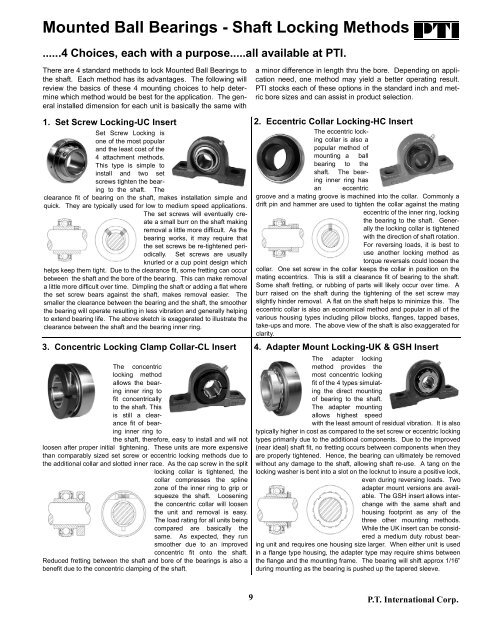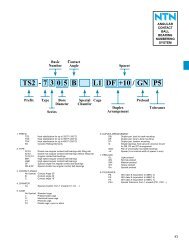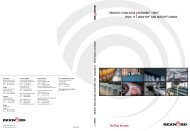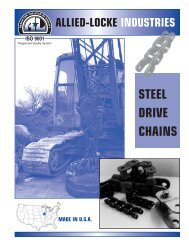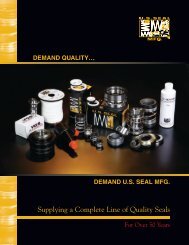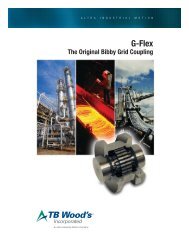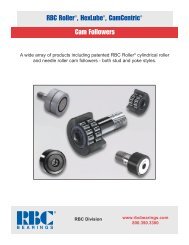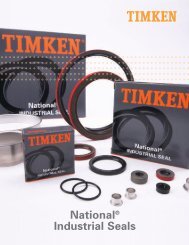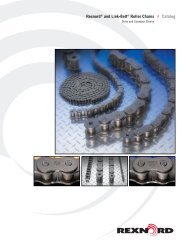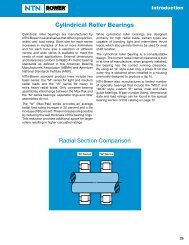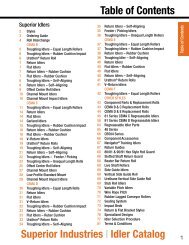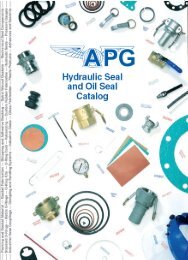PTI Bearing Catalog - Norfolkbearings.com
PTI Bearing Catalog - Norfolkbearings.com
PTI Bearing Catalog - Norfolkbearings.com
You also want an ePaper? Increase the reach of your titles
YUMPU automatically turns print PDFs into web optimized ePapers that Google loves.
Mounted Ball <strong>Bearing</strong>s - Shaft Locking Methods<br />
......4 Choices, each with a purpose.....all available at <strong>PTI</strong>.<br />
There are 4 standard methods to lock Mounted Ball <strong>Bearing</strong>s to<br />
the shaft. Each method has its advantages. The following will<br />
review the basics of these 4 mounting choices to help determine<br />
which method would be best for the application. The general<br />
installed dimension for each unit is basically the same with<br />
a minor difference in length thru the bore. Depending on application<br />
need, one method may yield a better operating result.<br />
<strong>PTI</strong> stocks each of these options in the standard inch and metric<br />
bore sizes and can assist in product selection.<br />
1. Set Screw Locking-UC Insert 2. Eccentric Collar Locking-HC Insert<br />
Set Screw Locking is<br />
one of the most popular<br />
and the least cost of the<br />
4 attachment methods.<br />
This type is simple to<br />
install and two set<br />
screws tighten the bearing<br />
to the shaft. The<br />
clearance fit of bearing on the shaft, makes installation simple and<br />
quick. They are typically used for low to medium speed applications.<br />
The set screws will eventually create<br />
a small burr on the shaft making<br />
removal a little more difficult. As the<br />
bearing works, it may require that<br />
the set screws be re-tightened periodically.<br />
Set screws are usually<br />
knurled or a cup point design which<br />
helps keep them tight. Due to the clearance fit, some fretting can occur<br />
between the shaft and the bore of the bearing. This can make removal<br />
a little more difficult over time. Dimpling the shaft or adding a flat where<br />
the set screw bears against the shaft, makes removal easier. The<br />
smaller the clearance between the bearing and the shaft, the smoother<br />
the bearing will operate resulting in less vibration and generally helping<br />
to extend bearing life. The above sketch is exaggerated to illustrate the<br />
clearance between the shaft and the bearing inner ring.<br />
The concentric<br />
locking method<br />
allows the bearing<br />
inner ring to<br />
fit concentrically<br />
to the shaft. This<br />
is still a clearance<br />
fit of bearing<br />
inner ring to<br />
the shaft, therefore, easy to install and will not<br />
loosen after proper initial tightening. These units are more expensive<br />
than <strong>com</strong>parably sized set screw or eccentric locking methods due to<br />
the additional collar and slotted inner race. As the cap screw in the split<br />
locking collar is tightened, the<br />
collar <strong>com</strong>presses the spline<br />
zone of the inner ring to grip or<br />
squeeze the shaft. Loosening<br />
the concentric collar will loosen<br />
the unit and removal is easy.<br />
The load rating for all units being<br />
<strong>com</strong>pared are basically the<br />
same. As expected, they run<br />
smoother due to an improved<br />
concentric fit onto the shaft.<br />
Reduced fretting between the shaft and bore of the bearings is also a<br />
benefit due to the concentric clamping of the shaft.<br />
The eccentric locking<br />
collar is also a<br />
popular method of<br />
mounting a ball<br />
bearing to the<br />
shaft. The bearing<br />
inner ring has<br />
an eccentric<br />
groove and a mating groove is machined into the collar. Commonly a<br />
drift pin and hammer are used to tighten the collar against the mating<br />
eccentric of the inner ring, locking<br />
the bearing to the shaft. Generally<br />
the locking collar is tightened<br />
with the direction of shaft rotation.<br />
For reversing loads, it is best to<br />
use another locking method as<br />
torque reversals could loosen the<br />
collar. One set screw in the collar keeps the collar in position on the<br />
mating eccentrics. This is still a clearance fit of bearing to the shaft.<br />
Some shaft fretting, or rubbing of parts will likely occur over time. A<br />
burr raised on the shaft during the tightening of the set screw may<br />
slightly hinder removal. A flat on the shaft helps to minimize this. The<br />
eccentric collar is also an economical method and popular in all of the<br />
various housing types including pillow blocks, flanges, tapped bases,<br />
take-ups and more. The above view of the shaft is also exaggerated for<br />
clarity.<br />
3. Concentric Locking Clamp Collar-CL Insert 4. Adapter Mount Locking-UK & GSH Insert<br />
The adapter locking<br />
method provides the<br />
most concentric locking<br />
fit of the 4 types simulating<br />
the direct mounting<br />
of bearing to the shaft.<br />
The adapter mounting<br />
allows highest speed<br />
with the least amount of residual vibration. It is also<br />
typically higher in cost as <strong>com</strong>pared to the set screw or eccentric locking<br />
types primarily due to the additional <strong>com</strong>ponents. Due to the improved<br />
(near ideal) shaft fit, no fretting occurs between <strong>com</strong>ponents when they<br />
are properly tightened. Hence, the bearing can ultimately be removed<br />
without any damage to the shaft, allowing shaft re-use. A tang on the<br />
locking washer is bent into a slot on the locknut to insure a positive lock,<br />
even during reversing loads. Two<br />
adapter mount versions are available.<br />
The GSH insert allows interchange<br />
with the same shaft and<br />
housing footprint as any of the<br />
three other mounting methods.<br />
While the UK insert can be considered<br />
a medium duty robust bearing<br />
unit and requires one housing size larger. When either unit is used<br />
in a flange type housing, the adapter type may require shims between<br />
the flange and the mounting frame. The bearing will shift approx 1/16”<br />
during mounting as the bearing is pushed up the tapered sleeve.<br />
9 P.T. International Corp.


